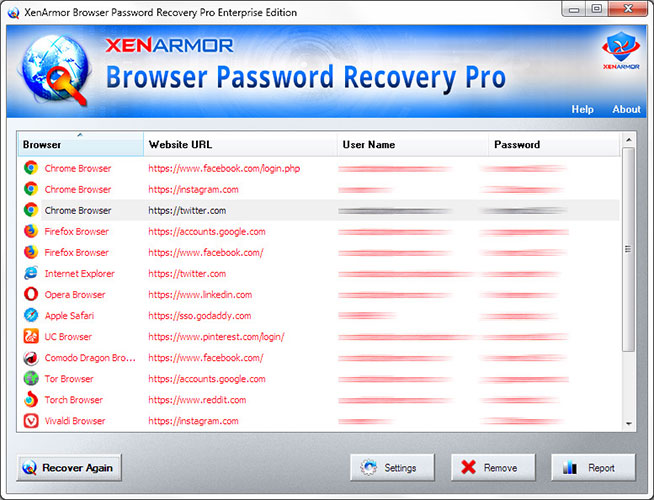How to Recover Saved Passwords in Internet Explorer

This research article exposes the password secrets of Internet Explorer including where all your website login passwords are stored, how it is stored and how to recover it automatically.
Internet Explorer Password Secrets
Latest version of Internet Explorer (v7.0 & higher) saves all the website login passwords in following Registry location,
[IE v7.0 & higher] HKEY_CURRENT_USER\Software\Microsoft\Internet Explorer\Intelliforms\storage2
Here each Registry value corresponds to each of the website login account stored. Also SHA1 hash of the website link is used as name for this Registry value and data contains encrypted username/password.
IE encrypts the website username & password using Windows DPAPI (Data Protection API) functions.
IE (v7.0 or higher) stores all HTTP Basic authentication (Router/Model login) passwords in Windows Credential Store.
Please refer to next sections for decrypting these passwords programmatically as well as automatically (last section).
Older version of IE (v4.0 to v6.0) used to store all the website passwords in Protected Storage at following Registry location,
[IE v4.0 to 6.0] HKEY_CURRENT_USER\Software\Microsoft\Protected Storage System Provider
The actual contents of this registry location are encrypted and not visible even in Windows Registry Editor.
Please refer to next section on how to decrypt these passwords programmatically and automatically.
Recover Old IE Version Passwords
IE older version uses Protected Storage to store website login passwords. To recover the passwords, we can use Windows functions like PStoreCreateInstance, EnumItems, ReadItem etc. to go through each of the website logins and recover the username & passwords as shown in sample c++ program below.
#import "pstorec.dll" no_namespace
void ListIEProtectedStorageSecrets()
{
IPStorePtr PStore;
IEnumPStoreTypesPtr EnumPStoreTypes;
GUID TypeGUID;
char strSiteUrl[1024];
char strSiteCredentials[1024];
char szItemGUID[1024];
char strUsername[1024];
char strPassword[1024];
HRESULT hRes = PStoreCreateInstance(&PStore, 0, 0, 0);
hRes = PStore->EnumTypes(0, 0, &EnumPStoreTypes);
while( EnumPStoreTypes->raw_Next(1, &TypeGUID, 0) == S_OK )
{
sprintf_s(szItemGUID, 1024, "%x", TypeGUID);
IEnumPStoreTypesPtr EnumSubTypes;
hRes = PStore->EnumSubtypes(0, &TypeGUID, 0, &EnumSubTypes);
GUID subTypeGUID;
while(EnumSubTypes->raw_Next(1,&subTypeGUID,0) == S_OK)
{
IEnumPStoreItemsPtr spEnumItems;
HRESULT hRes = PStore->EnumItems(0, &TypeGUID, &subTypeGUID, 0, &spEnumItems);
//Now enumerate through each of the stored entries.....
LPWSTR strWebsite;
while( spEnumItems->raw_Next(1, &strWebsite, 0) == S_OK)
{
sprintf_s(strSiteUrl, 1024, "%ws", siteName);
unsigned long psDataLen = 0;
unsigned char *psData = NULL;
char *sptr;
_PST_PROMPTINFO *pstiinfo = NULL;
//read the credentails for this website entry
hRes = PStore->ReadItem(0, &TypeGUID, &subTypeGUID, siteName, &psDataLen, &psData, pstiinfo, 0);
if( lstrlen((char *)psData)<(psDataLen-1) )
{
int i=0;
for(int m=0; m<psDataLen; m+=2)
{
if(psData[m]==0)
strSiteCredentials[i]=',';
else
strSiteCredentials[i]=psData[m];
i++;
}
strSiteCredentials[i-1]=0;
}
else
{
sprintf_s(strSiteCredentials, 1024, "%s", psData);
}
//Now decode the username & password from strSiteCredentials for different types
//5e7e8100 - IE:HTTP basic authentication based passwords
//username and passwords are seperated by ':'
if(lstrcmp(szItemGUID, "5e7e8100") ==0 )
{
strPassword[0]=0;
sptr = strstr(strSiteCredentials, ":");
if( sptr != NULL )
{
strcpy_s(strPassword, 1024, sptr+1);
*sptr = 0;
strcpy_s(strUsername, 1024, strSiteCredentials);
}
printf("\n website = %S, username = %s, password = %s", strSiteUrl, strUsername, strPassword);
}
//e161255a - IE autocomplete passwords
if(lstrcmp(szItemGUID,"e161255a")==0)
{
if(strstr(strSiteUrl, "StringIndex" ) == 0 )
{
if(strstr(strSiteUrl,":String")!=0)
*strstr(strSiteUrl,":String")=0;
lstrcpyn(strPassword,strSiteUrl,8);
if( !( (strstr(strPassword,"http:/")==0)&&(strstr(strPassword,"https:/")==0) ) )
{
//username & passwords are seperated by ','
strPassword[0]=0;
sptr = strstr(strSiteCredentials,",");
if( sptr != NULL )
{
strcpy_s(strPassword, 1024, sptr+1);
*sptr = 0;
strcpy_s(strUsername, 1024, strSiteCredentials);
}
printf("\n website = %s, username = %s, password = %s", strSiteUrl, strUsername, strPassword);
}
}
} //end of autocomplete if
} //inner while loop
} //middle while loop
} //top while loop
} //end of function
Recover New IE Version Passwords
As explained earlier, new version of Internet Explorer (v7.0 & higher) stores all website login passwords in the Registry location. Instead of directly storing website link, it uses SHA1 hash of website link. Also login username & passwords are encrypted using Windows DPAPI function CryptProtectData with Website URL as the salt data.
Here is the sample C++ program to decrypt website password using CryptUnprotectData function,
void RecoverIEPasswords(wchar_t *wstrURL)
{
char strIEStorageKey[]= "Software\\Microsoft\\Internet Explorer\\IntelliForms\\Storage2";
char strUrlHash[1024];
LONG status;
BOOL result;
HKEY hKey;
DWORD DWORD dwSize = 1024;
DWORD BufferLength=5000;
DWORD dwType;
BYTE Buffer[5000];
//Get the hash for the Website URL
GetSHA1Hash(wstrURL, strUrlHash, 1024);
//Now retrieve the encrypted credentials for this website link
//
if(ERROR_SUCCESS != RegOpenKeyEx(HKEY_CURRENT_USER, strIEStorageKey, 0, KEY_QUERY_VALUE, &hKey))
return;
//Now get the value...
status = RegQueryValueEx(hKey, strUrlHash, 0, &dwType, Buffer, &BufferLength);
RegCloseKey(hKey);
if( status != ERROR_SUCCESS || strlen((char*)Buffer) < 1 )
return;
//Now decrypt the website credentials....
//
DATA_BLOB DataIn;
DATA_BLOB DataOut;
DATA_BLOB OptionalEntropy;
DataIn.pbData = Buffer;
DataIn.cbData = BufferLength;
OptionalEntropy.pbData = (unsigned char*)wstrURL;
OptionalEntropy.cbData = (wcslen(wstrURL)+1)*2;
if( CryptUnprotectData(&DataIn, 0, &OptionalEntropy, NULL, NULL, 0, &DataOut) == FALSE )
{
printf("CryptUnprotectData failed with error 0x%.8x", GetLastError());
return;
}
//successfully decrypted password
//
//Now DataOut.pbData contains username & password in Unicode format
//
LocalFree(DataOut.pbData);
}
How to Recover IE Passwords Automatically
Here is simple way to recover all version Internet Explorer passwords without worrying about where it is stored and how to decrypt it.
You can use our XenArmor Browser Password Recovery Pro software to instantly & easily recover all your saved website login passwords from Internet Explorer as shown in video below,
Here are the simple steps to recover all your saved passwords,
- Step 1: Download & Install Browser Password Pro from here
- Step 2: Next launch the software on your computer
- Step 3: It will automatically discover, decrypt and display all the saved Internet Explorer passwords as shown below
For more details, please refer to Online User Guide
Hope this article has helped you to understand the password secrets of Internet Explorer.
Let us know what do you think. Please comment below if you have any queries or suggestions.
Recommended Posts

How to Recover Remote Desktop Password from UltraVNC
November 16, 2019




